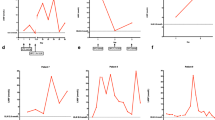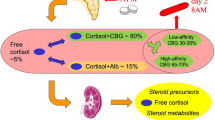Abstract
Background
For more than a decade, urinary free cortisol corrected for creatinine (OUFCC) has been used to assess the systemic bioactivity of inhaled corticosteroids in children with asthma. Paediatric normative ranges, however, have not been established. The aim of the present study was to define a preliminary range for OUFCC in Tanner stage 1 children.
Methods
A post hoc analysis was performed of 26 Tanner stage one children (aged 5–11 years) with mild asthma only requiring prn (pro re nata) treatment with short-acting β2-agonists, who participated in a 3-way cross-over knemometry study. The study comprised a run-in, two washout periods and three treatment periods (2 weeks each). Urine was collected at the end of each period. A normative range was derived using the 95% prediction interval for the geometric mean OUFCC, calculated from run-in and washout periods.
Results
Twenty-six children contributed 41 OUFCC values. The geometric mean OUFCC was 9.0 nmol/mmol (95% PI: 3.6, 22.7 nmol/mmol).
Conclusions
The OUFCC preliminary normative range was 3.6 to 22.7 nmol/mmol in Tanner stage one children. A larger study in healthy children is warranted to confirm these findings and to assess potential differences in OUFCC across developmental stages and age groups, and by gender and race.
EudraCT number
2013-004719-32,
ClinicalTrials.gov identifier
NCT02063139


Similar content being viewed by others
References
McIntyre HD, Mitchell CA, Bowler SD, Armstrong JG, Wooler JA, Cowley DM. Measuring the systemic effects of inhaled beclomethasone: timed morning urine collections compared with 24-h specimens. Thorax. 1995;50(12):1280–4.
Clark DJ, Grove A, Cargill RI, Lipworth BJ. Comparative adrenal suppression with inhaled budesonide and fluticasone propionate in adult asthmatic patients. Thorax. 1996;51(3):262–6.
Wilson AM, McFarlane LC, Lipworth BJ. Dose-response effect for adrenal suppression with repeated twice daily inhaled fluticasone propionate and triamcinolone acetonide in adult asthmatics. Am J Respir Crit Care Med. 1997;156(4 Pt 1):1274–7.
Fowler SJ, Orr LC, Wilson AM, Sims EJ, Lipworth BJ. Dose-response for adrenal suppression with hydrofluoroalkane formulations of fluticasone propionate and beclomethasone dipropionate. Br J Clin Pharmacol. 2001;52(1):93–5.
Wilson AM, McFarlane LC, Lipworth BJ. Effects of repeated once daily dosing of three intranasal corticosteroids on basal and dynamic measures of hypothalamic-pituitary-adrenal-axis activity. J Allergy Clin Immunol. 1998;101(4 Pt 1):470–4.
Fardon TC, Lee DK, Haggart K, McFarlane LC, Lipworth BJ. Adrenal suppression with dry powder formulations of fluticasone propionate and mometasone furoate. Am J Respir Crit Care Med. 2004;170(9):960–6.
Wilson AM, McFarlane LC, Lipworth BJ. Effects of low and high doses of inhaled flunisolide and triamcinolone acetonide on basal and dynamic measures of adrenocortical activity in healthy volunteers. J Clin Endocrinol Metab. 1998;83(3):922–5.
Nair A, McKinlay L, Williamson P, Short P, Burns P, et al. Comparative lung bioavailability of fluticasone/salmeterol via a breath-actuated spacer and conventional plastic spacers. Eur J Clin Pharmacol. 2011;67(4):355–63.
Dempsey OJ, Wilson AM, Coutie WJ, Lipworth BJ. Evaluation of the effect of a large volume spacer on the systemic bioactivity of fluticasone propionate metered-dose inhaler. Chest. 1999;116(4):935–40.
Nair A, Clearie K, Menzies D, Meldrum K, McFarlane L, et al. A novel breath-actuated integrated vortex spacer device increases relative lung bioavailability of fluticasone/salmeterol in combination. Pulm Pharmacol Ther. 2009;22(4):305–10.
Lee DK, Bates CE, Currie GP, Cowan LM, McFarlane LC, Lipworth BJ. Effects of high-dose inhaled fluticasone propionate on the hypothalamic-pituitary- adrenal axis in asthmatic patients with severely impaired lung function. Ann Allergy Asthma Immunol. 2004;93(3):253–8.
Mortimer KJ, Harrison TW, Tang Y, Wu K, Lewis S, Sahasranaman S, Hochhaus G, Tattersfield AE. Plasma concentrations of inhaled corticosteroids in relation to airflow obstruction in asthma. Br J Clin Pharmacol. 2006;62(4):412–9.
Clark DJ, Clark RA, Lipworth BJ. Adrenal suppression with inhaled budesonide and fluticasone propionate given by large volume spacer to asthmatic children. Thorax. 1996;51(9):941–3.
Agertoft L, Pedersen S. Lower-leg growth rates in children with asthma during treatment with ciclesonide and fluticasone propionate. Pediatr Allergy Immunol. 2010;21(1 Pt 2):e199–205.
Doull IJ, Freezer NJ, Holgate ST. Growth of prepubertal children with mild asthma treated with inhaled beclomethasone dipropionate. Am J Respir Crit Care Med. 1995;151(6):1715–9.
Wolthers OD, Hansen M, Juul A, Nielsen HK, Pedersen S. Knemometry, urine cortisol excretion, and measures of the insulin-like growth factor axis and collagen turnover in children treated with inhaled glucocorticosteroids. Pediatr Res. 1997;41(1):44–50.
Wolthers OD, Moore A, Mersmann S, Dissanayake S. Knemometry assessment of short-term lower leg growth in children with asthma treated with fluticasone propionate/formoterol combination therapy. J Aerosol Med Pulm Drug Deliv. 2017;30(5):373–80.
Rittig S, Kamperis K, Siggaard C, Hagstroem S, Djurhuus JC. Age related nocturnal urine volume and maximum voided volume in healthy children: reappraisal of International Children’s Continence Society definitions. J Urol. 2010;183(4):1561–7.
Ahmad S, Southall D. Pocket emergency paediatric care: a practical guide to the diagnosis and management of pedeatric emergencies in hospitals and other healthcare facilities. London: BMJ Books; 2008.
Tanner JM. Growth at Adolescence: with a general consideration of the effects of hereditary and environmental factors upon growth and maturation from birth to maturity. 2nd ed. Oxford: Blackwell; 1962.
Siemens Count-a-Coat® Cortisol product literature. http://www.meditecno.pt/Upload/Product/Archive/Cortisol,_Coat-A-Count_-_RIA_-_Rev_9_.pdf. Accessed 8 Oct 2017.
Zöllner EW, Lombard C, Galal U, Hough S, Irusen E, Weinberg E. Hypothalamic-pituitary-adrenal axis suppression in asthmatic children on inhaled and nasal corticosteroids: is the early-morning serum adrenocorticotropic hormone (ACTH) a useful screening test? Pediatr Allergy Immunol. 2011;22(6):614–20.
Wolthers OD, Schou AJ. Short-term growth after withdrawal of exogenous glucocorticoids. Horm Res. 2005;64(3):116–8.
Fink RS, Pierre LN, Daley-Yates PT, Richards DH, Gibson A, Honour JW. Hypothalamic-pituitary-adrenal axis function after inhaled corticosteroids: unreliability of urinary free cortisol estimation. J Clin Endocrinol Metab. 2002;87(10):4541–6.
Galeandro L, Sieber-Ruckstuhl NS, Riond B, Hartnack S, Hofmann-Lehmann R, Reusch CE, Boretti FS. Urinary corticoid concentrations measured by 5 different immunoassays and gas chromatography-mass spectrometry in healthy dogs and dogs with hypercortisolism at home and in the hospital. J Vet Intern Med. 2014;28(5):1433–41.
McCann SJ, Gillingwater S, Keevil BG. Measurement of urinary free cortisol using liquid chromatography-tandem mass spectrometry: comparison with the urine adapted ACS:180 serum cortisol chemiluminescent immunoassay and development of a new reference range. Ann Clin Biochem. 2005;42(Pt 2):112–8.
Zeugswetter FK, Neffe F, Schwendenwein I, Tichy A, Möstl E. Configuration of antibodies for assay of urinary cortisol in dogs influences analytic specificity. Domest Anim Endocrinol. 2013;45:98–104.
El-Farhan N, Rees DA, Evans C. Measuring cortisol in serum, urine and saliva—are our assays good enough? Ann Clin Biochem. 2017;54(3):308–22.
Kline GA, Buse J, Krause RD. Clinical implications for biochemical diagnostic thresholds of adrenal sufficiency using a highly specific cortisol immunoassay. Clin Biochem. 2017;50(9):475–80.
Wood L, Ducroq DH, Fraser HL, Gillingwater S, Evans C, Pickett AJ, Rees DW, John R, Turkes A. Measurement of urinary free cortisol by tandem mass spectrometry and comparison with results obtained by gas chromatography-mass spectrometry and two commercial immunoassays. Ann Clin Biochem. 2008;45(Pt 4):380–8. https://doi.org/10.1258/acb.2007.007119.
Fong BM, Tam S, Leung KS. Improved liquid chromatography-tandem mass spectrometry method in clinical utility for the diagnosis of Cushing’s syndrome. Anal Bioanal Chem. 2010;396:783–90.
Honour JW. Development and validation of a quantitative assay based on tandem mass spectrometry. Ann Clin Biochem. 2011;48:97–111.
Wilson AM, Clark DJ, McFarlane L, Lipworth BJ. Adrenal suppression with high doses of inhaled fluticasone propionate and triamcinolone acetonide in healthy volunteers. Eur J Clin Pharmacol. 1997;53(1):33–7.
Morice AH, Hochmuth L, Ekelund J, Thorén A, Puterman AS. Comparable long-term safety and efficacy of a novel budesonide/formoterol pressurized metered-dose inhaler versus budesonide/formoterol Turbuhaler in adolescents and adults with asthma. Pulm Pharmacol Ther. 2008;21(1):32–9.
Pohunek P, Kuna P, Jorup C, De Boeck K. Budesonide/formoterol improves lung function compared with budesonide alone in children with asthma. Pediatr Allergy Immunol. 2006;17(6):458–65.
Malone R, LaForce C, Nimmagadda S, Schoaf L, House K, et al. The safety of twice-daily treatment with fluticasone propionate and salmeterol in pediatric patients with persistent asthma. Ann Allergy Asthma Immunol. 2005;95(1):66–71.
Verona E, Petrov D, Cserhati E, Hofman J, Geppe N, et al. Fluticasone propionate in asthma: a long-term dose comparison study. Arch Dis Child. 2003;88(6):503–9.
Wolthers OD, Walters EG. Short-term lower leg growth in 5- to 11-year-old asthmatic children using beclomethasone dipropionate inhalers with chlorofluorocarbon or hydrofluoroalkane propellants: a 9-week, open-label, randomized, crossover, noninferiority study. Clin Ther. 2011;33(8):1069–76.
Acknowledgements
The authors would like to thank study participants and nurses Signe Dreier and Anne Karina Kjaer for help with recruiting and taking care of the children in the study. This work was funded by Mundipharma Research Limited, Cambridge, United Kingdom.
Author information
Authors and Affiliations
Contributions
Ole D. Wolthers was the Principal Investigator for the study; Sabine Mersmann was the study Statistician, and Sanjeeva Dissanayake was the Clinical Lead. Sanjeeva Dissanayake drafted the manuscript and Ole D. Wolthers and Sabine Mersmann commented on it. All authors have accepted responsibility for the entire content of this submitted manuscript and approved submission.
Corresponding author
Ethics declarations
Funding
The parent study upon which this research was based was sponsored by Mundipharma Research Ltd.
Conflict of interest
Ole D. Wolthers was the Principal Investigator for this study. Sabine Mersmann and Sanjeeva Dissanayake were full-time employees of the study sponsor, Mundipharma Research Ltd at the time the study was undertaken. The authors have no other financial relationships relevant to this article to disclose.
Ethics approval
The study was conducted in accordance with the International Guidelines issued by the European Commission in 1990 and the Declaration of Helsinki and approved by the Danish Health and Medicines Authority and Ethics Committee Region Midtjylland. Written informed consent was obtained from both parents/guardians, and assent from the child, before any trial procedure was carried out.
Trade mark statements
® FLUTIFORM is a registered trade mark of Jagotec AG. AEROCHAMBER PLUS and FLOW-VU are registered trade-marks of Trudell. Medical International. FLIXOTIDE and VOLUMATIC are registered trade-marks of Glaxo Group Limited. AEROBEC is a registered trade mark in Europe of either Meda AB or Teva Pharmaceuticals International GmbH. QVAR and AIROMIR are registered trade-marks in Europe of either IVAX International GmbH, Teva Pharmaceuticals International GmbH or 3M Company. AUTOHALER is a registered trade mark of 3M Company. COAT-A-COUNT is a registered trade mark in the United States of Siemens Healthcare Diagnostics Inc.
Additional information
S. Dissanayake: Address at the time this study was conducted
Rights and permissions
About this article
Cite this article
Wolthers, O.D., Mersmann, S. & Dissanayake, S. A Pilot Study of the Normative Range of Overnight Urinary Free Cortisol Corrected for Creatinine in Children. Clin Drug Investig 38, 313–318 (2018). https://doi.org/10.1007/s40261-017-0609-x
Published:
Issue Date:
DOI: https://doi.org/10.1007/s40261-017-0609-x




